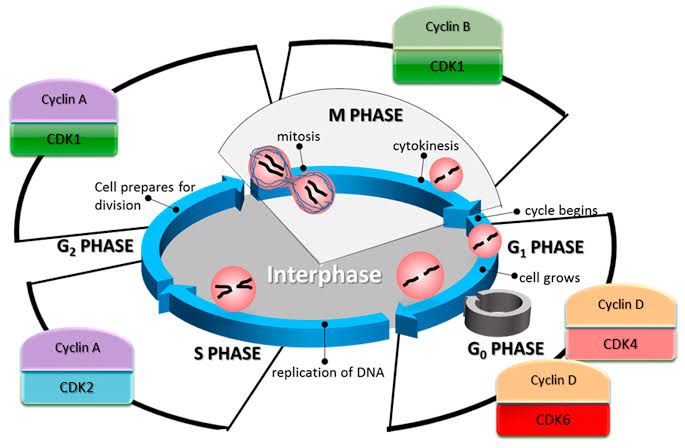
Activation of Cyclin-Dependent Protein Kinases (CDKs) by Cyclin
Cyclin-dependent protein kinases (CDKs) are crucial regulators of the cell cycle. Their activation is primarily dependent on the binding of cyclins, which are regulatory proteins whose levels fluctuate throughout the cell cycle.
- Binding Mechanism: CDKs exist in an inactive form when not bound to cyclins. The binding of a specific cyclin to a CDK induces a conformational change in the kinase, activating its catalytic activity. This interaction is essential for the phosphorylation of target substrates that drive cell cycle progression.
- Cyclin Variants: Different types of cyclins (e.g., Cyclin A, B, D, E) activate specific CDKs at various stages of the cell cycle. For example, Cyclin D activates CDK4 and CDK6 during the G1 phase, while Cyclin E activates CDK2 as cells transition from G1 to S phase.
- Phosphorylation: In addition to cyclin binding, some CDKs require phosphorylation at specific threonine and tyrosine residues for full activation. This dual mechanism ensures that CDKs are precisely regulated in response to cellular signals.
Regulation of CDKs; Controlled Degradation of Cyclin
The regulation of CDKs is critical for ensuring proper cell cycle progression and preventing uncontrolled cell division.
- Cyclin Degradation: The levels of cyclins are tightly controlled through proteolysis, primarily via the ubiquitin-proteasome pathway. Once a cyclin has fulfilled its role in activating its corresponding CDK, it is tagged with ubiquitin molecules by specific E3 ligases (e.g., APC/C for Cyclins A and B).
- Proteasomal Degradation: The ubiquitinated cyclins are then recognized and degraded by the 26S proteasome, leading to a decrease in their concentration within the cell. This degradation effectively inactivates the associated CDK, allowing for proper timing in cell cycle transitions.
- Feedback Mechanisms: The degradation process is often coupled with feedback mechanisms that ensure that once certain phases are completed (like mitosis), the corresponding cyclins are degraded to prevent re-initiation until conditions are favorable again.
Regulated Synthesis of CDKs and Cyclins
The synthesis of both CDKs and cyclins is also tightly regulated to ensure that they are available at appropriate times during the cell cycle.
- Transcriptional Regulation: The genes encoding cyclins and some CDKs are regulated at the transcriptional level by various signaling pathways and transcription factors (e.g., E2F family for Cyclin E). These factors respond to external growth signals or internal checkpoints.
- Post-Translational Modifications: After synthesis, both CDKs and cyclins can undergo post-translational modifications such as phosphorylation or acetylation that can influence their stability or activity.
- Cell Cycle Specificity: The expression patterns of different cyclins vary throughout the cell cycle; for instance, Cyclin D levels rise during G1 phase due to growth factor signaling while Cyclin B accumulates during G2 phase in preparation for mitosis.
In summary, the activation of cyclin-dependent protein kinases (CDKs) occurs through binding with specific cyclins which induce conformational changes necessary for their activity; regulation involves controlled degradation of these cyclins via ubiquitination leading to proteasomal degradation; additionally, regulated synthesis ensures that both CDKs and cyclins are produced at appropriate times during the cell cycle through transcriptional control and post-translational modifications.







